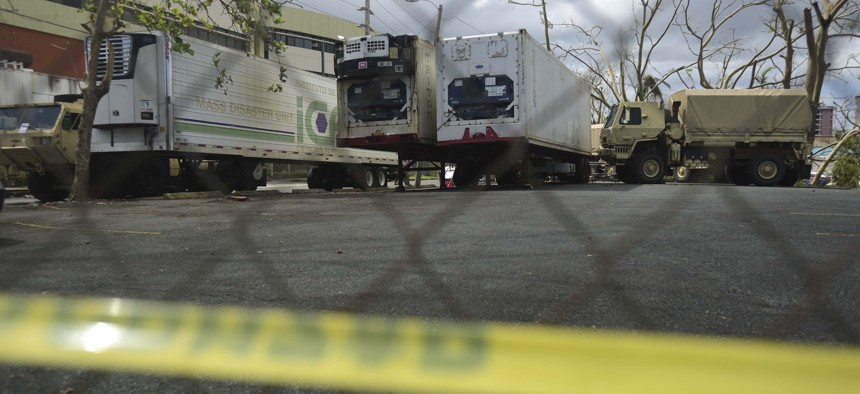Study: Hurricane Death Toll in Puerto Rico May be 70 Times Official Count

Three containers for holding corpses, right, are parked outside the Institute of Forensic Science, brought in to give support in the aftermath of Hurricane Maria in San Juan, Puerto Rico, Monday, Oct. 2, 2017. AP Photo/Carlos Giusti
The official fatality figure after Hurricane Maria was 64. New research indicates it could exceed 5,000.
The death toll in Puerto Rico associated with last year's Hurricane Maria could be more than 70 times the official count, a new study suggests.
Research published Tuesday by The New England Journal of Medicine estimates that the number of people who perished between Sept. 20, 2017, when the storm made landfall on the island, and Dec. 31, 2017, may be around 5,000. The official figure is 64.
Multiple press reports have previously raised questions about the official death toll from Hurricane Maria in the U.S. territory, and whether it was inaccurately low.
The study relied on a random survey of 3,299 households, asking participants about displacement, infrastructure loss and causes of death.
Estimates derived from the survey results indicate that the number of "excess deaths" following the storm was 4,645. (Excess deaths were calculated by comparing estimated post-hurricane mortality rates with official rates for the same time period during 2016.)
But the researchers, who include experts from Harvard's T.H. Chan School of Public Health, suspect that the 4,645 figure is likely conservative due to "survivor bias" and other factors. They say in the study appendix that a crude estimate of the excess deaths that occurred after Hurricane Maria in Puerto Rico is about 5,740. And they're 95 percent confident that the figure is between 1,506 and 9,889.
Delayed or interrupted health care were to blame for about one-third of the deaths households reported in the survey.
"Health care disruption is now a growing contributor to both morbidity and mortality in natural disasters," the authors note.
"In the United States, this phenomenon has been observed in the aftermaths of Hurricane Katrina, Superstorm Sandy, and more recently Hurricanes Harvey and Irma, in which nursing home residents and those dependent on life-sustaining equipment were disproportionately affected," they added.
Survey respondents said that they had problems in the wake of the storm getting medication, using electric-powered respiratory equipment, and getting access to medical facilities, as many were closed or damaged.
The researchers highlight two types of difficulties when it comes to officials in Puerto Rico producing timely and accurate fatality figures after a natural disaster like Hurricane Maria.
One is that the Institute of Forensic Sciences has to verify disaster-related deaths, which requires bodies to be brought to San Juan or for medical examiners to travel. This can delay death certificates.
Another is that deaths directly linked to a storm, like a person killed by flying debris, can be easier to classify than those that are indirect, like when a person can't access medical care for an illness.
Some of the other findings from the study were that, on average, households went 84 days without electricity, 68 days without water and 41 days without cell phone service from the time the hurricane hit late September, until the end of last December.
A full copy of the study can be found here.
Bill Lucia is a Senior Reporter for Government Executive's Route Fifty and is based in Washington, D.C.
NEXT STORY: Should There Be Mandatory Training Standards for School Resource Officers?






